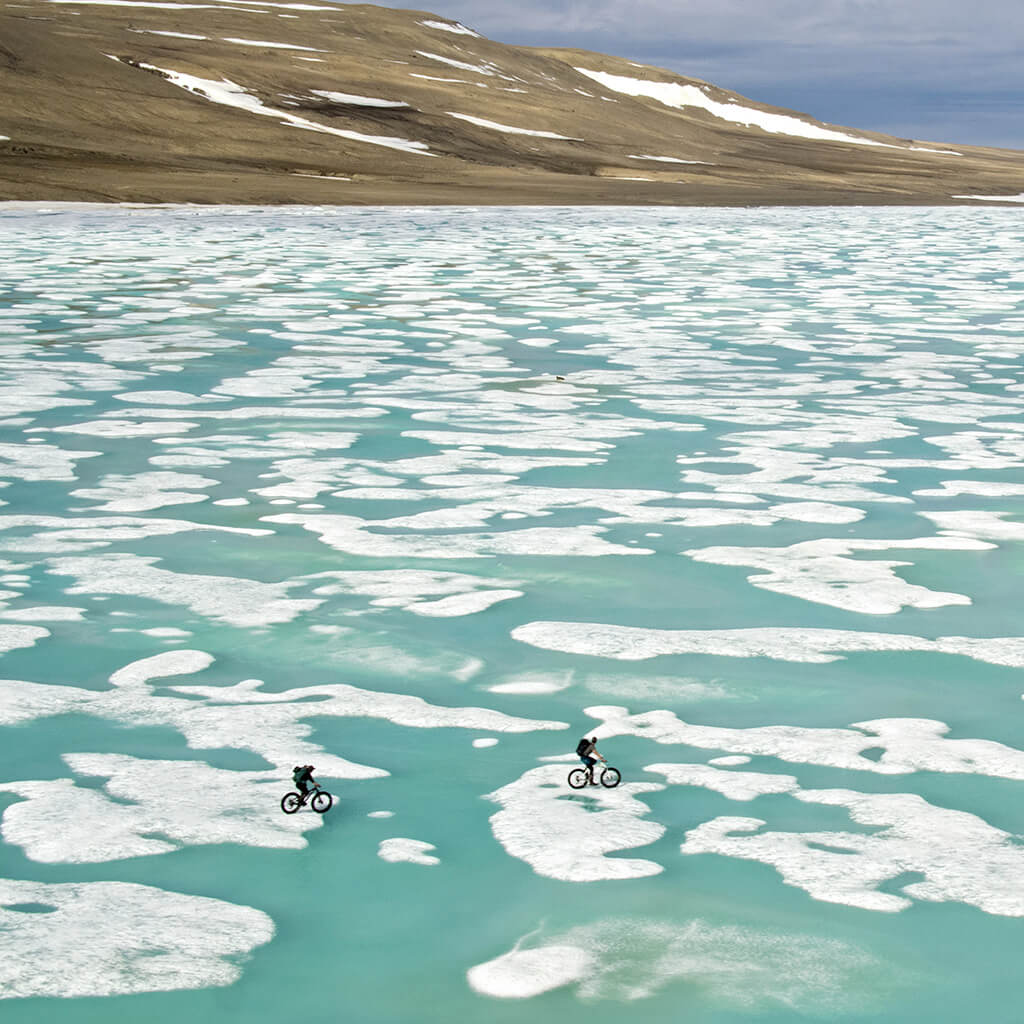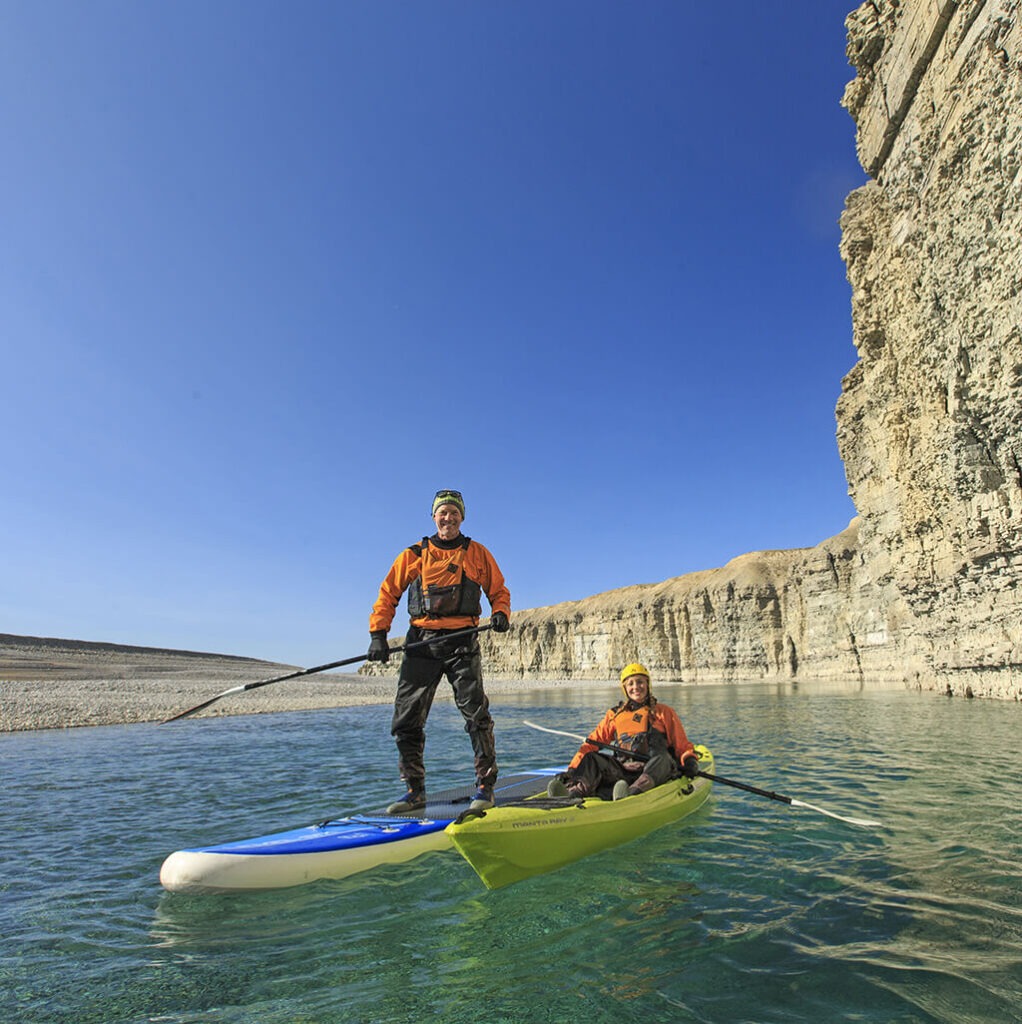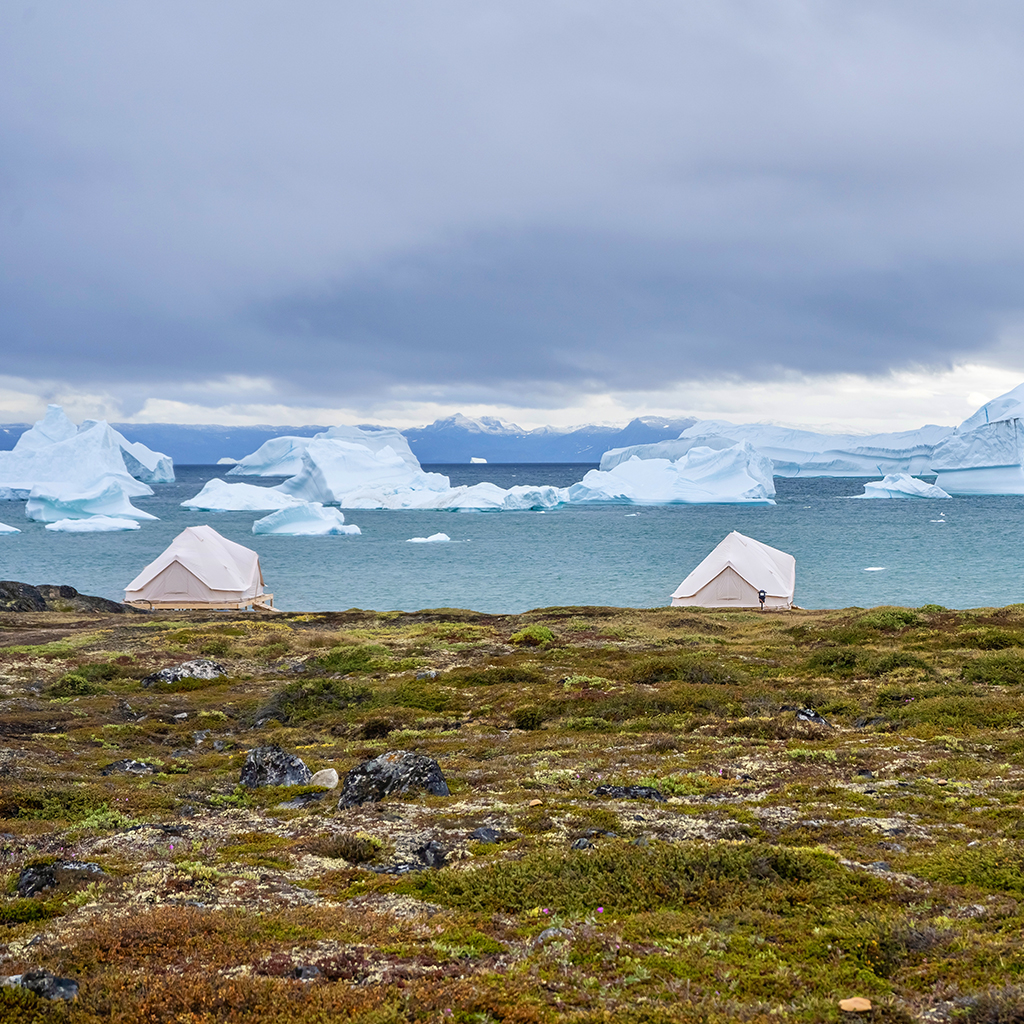
Polar bears pad on frisbee-sized paws over a landscape of white. Narwhals and belugas negotiate bright-blue channels between ice floes. Residents of remote outposts fish through holes in the ice, surrounded by thousands of miles of silence…
The Arctic captivates you. It fills you with awe and just a touch of adrenaline – until the credits roll over the documentary, or you look up from Instagram, and you snap back to reality… somewhere far south of the 66th parallel. In a world that gets smaller every year, it’s hard to think of places that still feel like open frontiers. But it can be even harder to picture yourself on a frontier-style trip, say, to the Arctic Circle.
So, can you go to the Arctic? If you’re not a local, an extreme athlete, a scientist, or a world-renowned photographer, are these places really for you? Sure, a few big boats can get you beyond the Arctic Circle, or a crazy bus ride from Fairbanks, but… then what? (And no, we don’t expect you to bike there, haha)
Before you give up and book another trip to Europe, consider this: You were born in one of the best times in human history to visit the Arctic as an adventure-spirited “normal traveler.”
We’ll get into why in a moment. We’ll also dive into the practical matter of how to get to the Arctic Circle, and what you can expect (and plan for) on a trip to one of Earth’s most remote and beautiful destinations.
Now’s the Best Time in History to Visit the Arctic
Before we dive into logistics, let’s pause for a moment to appreciate what we’re dealing with here. If traveling to the Arctic is audacious today, for most of history, it was flat-out impossible!
While over 40 indigenous groups have called the Arctic home for thousands of years, their populations stayed small, and communities were widely scattered. People from lower latitudes have also felt the pull of the Arctic for thousands of years. The earliest documented expedition was led by the Greek sailor Pytheas around 330 BC (he described the frozen ocean as “congealed”). But most Southerners retreated quickly – they didn’t have the skills to survive long. It wasn’t until the 1950s and 1960s that modern technology entered the Arctic and the human population started to grow.
Fast forward 70 more years, and today, Arctic routes and destinations are traveled, safe, and open to any willing adventurer. But the conditions are as harsh as ever, so there’s still plenty of untamed wilderness, wildlife and potential. Few other destinations on Earth can claim to strike this balance. That’s why the Arctic might just be the best destination for experienced travelers looking for a bucket-list adventure.
But things are changing quickly.
The Arctic is warming three times faster than the global average. The effects of the melting ice and rising temperature are obvious to people and animals alike. Every summer, chunks of glacier crash into the sea, and polar bears paddle in search of stable ground.
We live in a crossroads moment. Now may be our last chance to experience the Arctic as it has been for most of human history. It’s also more important than ever to travel to the Arctic consciously and sustainably… and spread awareness of these awe-inspiring, imperiled landscapes.
Fortunately, many Arctic tourism outfits prioritize sustainability, provide support to scientists and conservationists, and set aside profits for charity. For example, our partners for our Arctic adventure (we’ll talk about later in this post) created the Arctic Watch Beluga Foundation, which travelers automatically contribute to just by adventuring with us. A win/win if we ever saw one.
This makes it easier than ever not just to visit the Arctic, but to do so in a way that’s ethical and sustainable.
Note that we said “easier,” not “easy.” You’re bound to face some unique logistical hurdles as you plan an Arctic trip. Let’s break those down.
How To Get To The Arctic Circle and Where To Stay

You can feel the rigors of an Arctic Circle trip long before you touch down. Beyond the research that goes into…
- Knowing the best times (and how!) to view Arctic Wildlife.
- Figuring out what to pack to stay safe and comfortable.
- Setting an itinerary full of seasonally appropriate activities.
…there’s the not-so-simply matter of how to get to the Arctic and where to stay.
As you might imagine, the few airports in the Arctic Circle aren’t exactly major airline hubs. And they certainly don’t get you all the way to the destination-worthy outpost of your dreams. Accommodations look different, too: this isn’t the time to use up those extra points at a major chain hotel. (And that’s a good thing – you don’t want to stay at a Marriott on the tundra, do you?)
All this remoteness is part of the Arctic’s romantic allure. But it means it’s even more important to get your details squared away, correctly, well in advance!
The Arctic touches 8 different countries around the world, but for the rest of this article, we’ll be focusing on a trip to the Canadian Arctic, specifically the province of Nunavut. The northern most fly-camp in the world is here, and where we send intrepid travelers on our Arctic Yoga Adventure.
Instead of a hotel and a direct airline flight, here’s what you should expect:
The Destination: a Wilderness Lodge – Nunavut, Canada
A wilderness lodge is a remote outpost that acts as a home base for seasoned adventurers and first-time visitors alike. This is your hotel alternative on the tundra.
Our destination, Arctic Watch, happens to be the most northerly fly-in wilderness lodge in the world. At 74 degrees north, it sits at the shore of the Northwest Passage on Somerset Island. Though the buildings look a little bit like those “bubbles” that house sporting events, don’t let appearances fool you! Your room comes furnished with thick duvets and heavy curtains to block out the midnight sun. Meals are gourmet and as locally sourced as possible (fresh Arctic char anyone?).
The lodge is accessible by weekly charter flights, which brings us right back to transportation.
The Journey: Charter Flight from Yellowknife, Canada
The most common way to get to a remote outpost in Canadian Arctic is a combination of commercial and charter air travel, and our destination on Somerset Island is no different.
Your first step: take a regularly scheduled airline flight to Yellowknife, Northwest Territories (YZF). This airport serves as Northwest Canada’s major hub for charter companies, which carry passengers to dozens of far-off destinations just like ours.
Tip: Don’t be surprised if your fight to Yellowknife gets delayed! That’s normal up here – the Arctic isn’t known for forgiving weather conditions. (Yet another reason travel insurance is required on this adventure)
You’ll have a night in Yellowknife (included in your adventure with us) before our charter flight takes off the next day. It’s a happening little town, in a quaint sort of way, and well worth an afternoon stroll by the quayside before dinner.
In the morning, it’s off to the next phase of travel: your charter flight. We’ll take you to the charter company’s base (separate from the main airport terminal) to hop onboard the 70-passenger plane. Three hours later, you’ll touch down on the lodge’s isolated runway.
Arctic Travel: What You’ll Do and What To Expect

Congratulations! You’re on your way to an Arctic adventure!! After all the work, it’s time to take in the untamed beauty that now surrounds you.
When you wake up in the Arctic Circle each morning and pull back the heavy curtains, the sun will be as high in the sky as the night before, beckoning you to explore.
There’s no shortage of unworldly wildlife to see each day, including Beluga whales that come right up to the shoreline, rubbing their blubby bellies on the smooth stones feet away from where you stand, and tundra blown, sci-fi worthy, whale bones farther inland that you’d expect. The Arctic is adventure surrounded by the incredible… the unbelievable.
And yes, our adventure is, of course, a yoga adventure. Like everywhere else we go, this is an adventure, not a retreat, so although you’ll get to soak into your practice (overlooking some amazing vistas, by the way), our focus for you is on experiencing the Arctic on food, by bike, in a kayak and on and on… here’s a wee taste of what’s in store:
- Hiking the Lancaster Sound, Northwest Passage, waterfalls, canyons and Viking archeological sites.
- Guided wildlife viewing: Somerset Island is home to arctic foxes, belugas, muskoxen, snowy owls, and yes, polar bears.
- Riding ATVs and e-bikes to cover more ground as you explore the tundra.
- Cutting across frigid turquoise waters on a kayak or SUP (we’ll dry-suit you up, but balance is your real buddy!)
- Exploring 8,000 year-old bowhead whale skeletons in the Badlands
- Fishing for Arctic Char (catch and release to protect local fish populations)
- Learning from expert, world-renowned, polar explorers, wildlife photographers and guides at intimate informal lectures
Why Explore the Arctic with an Experiential Travel Group?
From chartering an airplane to lining up daily excursions, planning an Arctic trip is enough to make even the most experienced traveler’s head spin. That’s why joining an experiential travel group might be your best option.
When you’re part of a group, you’re able to secure exclusive experiences like the ones we just discussed. More importantly, you’ll share in the wind-swept awe of the Arctic with others who feel the same way. The remoteness of the Arctic makes it hard to plan a visit on your own. And that’s a good thing! It’s how you know that this is one of the last truly wild regions on Earth.
The Travel Yogi offers adventures for people who want to fully immerse themselves in their destination – while bringing wellness with them on the road. Our Arctic Yoga Adventure is no different.
Ready to venture to the roof of the world and take that trip you once thought was impossible? Windswept expanses, icy adventures, and maybe even polar bears are waiting for you.

